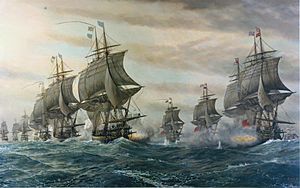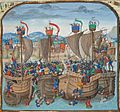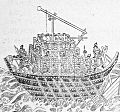Naval warfare facts for kids
Naval warfare is about fighting battles on or in the water. This includes seas, oceans, and even large lakes or rivers. It's a big part of how countries fight wars. People have been fighting on the water for over 3,000 years!
In the past, naval warfare mostly meant one group of ships fighting another group. But today, it's much more. It includes landing soldiers and equipment from the sea onto land, moving people and supplies across water, and helping land armies from the sea. New things like Submarines, aircraft carriers, and special forces have completely changed how naval battles are fought.
Contents
Naval warfare is any kind of combat that happens on, under, or above the water. It's a key part of a country's overall plan during a war. The main goal is often to control the seas. This control allows a country to move its troops and supplies safely. It also lets them stop enemies from doing the same.
Why is Control of the Sea Important?
Controlling the sea means a country can:
- Move its army and supplies to different places.
- Block enemy ships from bringing in food or weapons.
- Launch attacks from the water onto land.
- Protect its own trade routes.
For thousands of years, countries with strong navies often had more power. They could explore new lands, trade easily, and defend their borders.
The first naval battles happened a very long time ago. People used simple boats to fight on rivers and close to shore. As boats got bigger and better, battles moved to the open sea.
Ancient Ships and Tactics
Ancient civilizations like the Greeks and Romans built powerful warships. One famous type was the trireme. This ship had three rows of oars on each side. It was fast and could ram enemy ships.
- Ramming: Ships would try to smash into the side of an enemy ship. This could sink it or break its oars.
- Boarding: Sailors would try to get onto an enemy ship. Then, they would fight hand-to-hand with swords and spears.
A very famous early naval battle was the Battle of Salamis in 480 BC. The smaller Greek fleet defeated the much larger Persian fleet. They used clever tactics and their knowledge of the local waters.
Over time, ships changed. Sails became more important than oars for long journeys. Cannons were added to ships, changing how battles were fought. Instead of just ramming or boarding, ships could now shoot at each other from a distance.
- Galleons: These large sailing ships were used for both trade and war. They had many cannons.
- Line of Battle: Navies started fighting in a "line of battle." Ships would form a long line. This allowed them to fire all their side cannons at the enemy.
The Battle of Trafalgar in 1805 is a famous example of a sailing ship battle. The British navy, led by Admiral Nelson, won a huge victory against the French and Spanish fleets.
The 19th and 20th centuries brought huge changes to naval warfare. New technologies made ships faster, stronger, and more deadly.
The Age of Iron and Steam
- Steam Power: Steam engines replaced sails. This made ships faster and able to move against the wind.
- Ironclads: Ships started to be covered in thick iron plates. This made them much harder to sink. The first battle between ironclad warships was in 1862 during the American Civil War. It was between the USS Monitor and the CSS Virginia.
- Dreadnoughts: In 1906, the British built HMS Dreadnought. This battleship was so powerful that it made all other battleships old-fashioned. It had many large guns and was very fast.
World Wars and Beyond
The two World Wars (1914-1918 and 1939-1945) saw huge naval battles.
- Submarines: These underwater boats became very important. They could sink enemy ships without being seen.
- Aircraft Carriers: These ships are like floating airfields. They carry many airplanes that can attack enemy ships or targets on land. The Battle of the Coral Sea and the Battle of Midway were famous carrier battles during World War II. In these battles, the ships never even saw each other! All the fighting was done by planes.
- Naval Aviation: Planes launched from carriers became a main way to attack. They could drop bombs or torpedoes.
Today, naval warfare is very high-tech. Modern navies use:
- Guided Missiles: These missiles can hit targets hundreds of miles away.
- Nuclear Submarines: These submarines can stay underwater for months. They can carry powerful missiles.
- Advanced Aircraft: Modern fighter jets and helicopters fly from aircraft carriers.
- Special Forces: Small teams of highly trained soldiers often work with navies for special missions.
- Amphibious Warfare: This is when naval forces land troops and equipment on enemy shores.
Naval warfare is still about controlling the seas. But now, it's also about projecting power far from home. It involves complex teamwork between ships, submarines, aircraft, and land forces.
Images for kids
-
Battle between the British frigate Shannon and the American frigate Chesapeake, painted in 1836 by Christoffer Wilhelm Eckersberg and depicting the capture of USS Chesapeake.
-
An ancient Greek trireme vessel
-
The epic Battle of Salamis between Greek and Persian naval forces.
-
A Roman naval bireme depicted in a relief from the Temple of Fortuna Primigenia in Praeneste (Palastrina), which was built c. 120 BC; exhibited in the Pius-Clementine Museum (Museo Pio-Clementino) in the Vatican Museums.
-
The naval battle of Sluys, 1340, from Jean Froissart's Chronicles
-
A Song dynasty naval river ship with a Xuanfeng traction-trebuchet catapult on its top deck, from an illustration of the Wujing Zongyao (1044)
-
A Chinese paddle-wheel driven ship, from a Qing dynasty encyclopedia published in 1726
-
A replica of Korean turtle ship
-
An Eastern Han (25–220 AD) Chinese pottery boat fit for riverine and maritime sea travel, with an anchor at the bow, a steering rudder at the stern, roofed compartments with windows and doors, and miniature sailors.
-
A Song dynasty louchuan with a trebuchet, depicted in the Wujing Zongyao
-
The early-17th-century galleon Vasa on display at the Vasa Museum in Stockholm. Vasa, with its high stern castle and double battery decks, was a transitional design between the preferences for boarding tactics and the line of battle.
-
The Battle of the Saintes fought on 12 April 1782 near Guadeloupe
-
The 1805 Battle of Trafalgar
-
The first battle between ironclads: CSS Virginia/Merrimac (left) vs. USS Monitor, in 1862 at the Battle of Hampton Roads
-
The Battle of Bomarsund during the Åland War (1854–1856), the part of the Crimean War. A sketch of the quarter deck of HMS Bulldog in Bomarsund, Edwin T. Dolby, 1854
-
HMS Dreadnought, the first dreadnought battleship
-
HMS Prince of Wales and HMS Repulse during the air attack
-
Aircraft carrier USS Lexington under heavy air attack during the Battle of the Coral Sea, the first carrier-versus-carrier battle in history.
-
Aircraft carrier USS Yorktown hit by an aerial torpedo during the Battle of Midway
-
Battle of Savo Island was the first in a series of night-time engagements between surface warships during the Solomon Islands campaign.
-
USS Theodore Roosevelt launches an F-14 Tomcat while F/A-18 Hornets wait their turn during the Kosovo War
-
A United States Naval Landing Craft Air Cushion in the Pacific Ocean (2012)
See also
 In Spanish: Guerra naval para niños
In Spanish: Guerra naval para niños





























